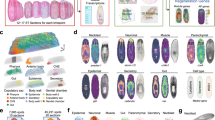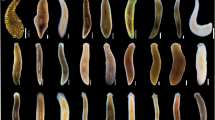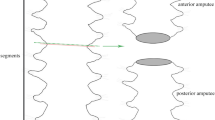Abstract
Variability of regenerative potential among animals has long perplexed biologists1. On the basis of their exceptional regenerative abilities, planarians have become important models for understanding the molecular basis of regeneration2. However, planarian species with limited regenerative abilities are also found3,4. Despite the importance of understanding the differences between closely related, regenerating and non-regenerating organisms, few studies have focused on the evolutionary loss of regeneration5, and the molecular mechanisms leading to such regenerative loss remain obscure. Here we examine Procotyla fluviatilis, a planarian with restricted ability to replace missing tissues6, using next-generation sequencing to define the gene expression programs active in regeneration-permissive and regeneration-deficient tissues. We found that Wnt signalling is aberrantly activated in regeneration-deficient tissues. Notably, downregulation of canonical Wnt signalling in regeneration-deficient regions restores regenerative abilities: blastemas form and new heads regenerate in tissues that normally never regenerate. This work reveals that manipulating a single signalling pathway can reverse the evolutionary loss of regenerative potential.
This is a preview of subscription content, access via your institution
Access options
Subscribe to this journal
Receive 51 print issues and online access
$199.00 per year
only $3.90 per issue
Buy this article
- Purchase on Springer Link
- Instant access to full article PDF
Prices may be subject to local taxes which are calculated during checkout



Similar content being viewed by others
Accession codes
Accessions
BioProject
Gene Expression Omnibus
Data deposits
Sequence read archive (SRA) data reported in this paper were deposited at NCBI as a BioProject under accession number PRJNA205293. RNA-seq analyses have been deposited in the NCBI Gene ExpressionOmnibus under accession number GSE48497.
References
Bely, A. E. Evolutionary loss of animal regeneration: pattern and process. Integr. Comp. Biol. 50, 515–527 (2010)
Newmark, P. A. & Sánchez Alvarado, A. Not your father’s planarian: a classic model enters the era of functional genomics. Nature Rev. Genet. 3, 210–219 (2002)
Lillie, F. R. Notes on regeneration and regulation in planarians. Am. J. Physiol. 6, 129–141 (1901)
Morgan, T. H. Notes on regeneration. Biol. Bull. 6, 159–172 (1904)
Bely, A. E. & Nyberg, K. G. Evolution of animal regeneration: re-emergence of a field. Trends Ecol. Evol. 25, 161–170 (2010)
Kenk, R. Biota of Freshwater Ecosystems Identification Manual No. 1: Freshwater planarians (Turbellaria) of North America (US Environmental Protection Agency, 1972)
Wenemoser, D., Lapan, S. W., Wilkinson, A. W., Bell, G. W. & Reddien, P. W. A molecular wound response program associated with regeneration initiation in planarians. Genes Dev. 26, 988–1002 (2012)
Pellettieri, J. et al. Cell death and tissue remodeling in planarian regeneration. Dev. Biol. 338, 76–85 (2010)
Wenemoser, D. & Reddien, P. W. Planarian regeneration involves distinct stem cell responses to wounds and tissue absence. Dev. Biol. 344, 979–991 (2010)
Gurley, K. A., Rink, J. C. & Sánchez Alvarado, A. β-catenin defines head versus tail identity during planarian regeneration and homeostasis. Science 319, 323–327 (2008)
Petersen, C. P. & Reddien, P. W. Smed-Bcatenin-1 is required for anteroposterior blastema polarity in planarian regeneration. Science 319, 327–330 (2008)
Yazawa, S., Umesono, Y., Hayashi, T., Tarui, H. & Agata, K. Planarian Hedgehog/Patched establishes anterior-posterior polarity by regulating Wnt signaling. Proc. Natl Acad. Sci. USA 106, 22329–22334 (2009)
Rink, J. C., Gurley, K. A., Elliott, S. A. & Sánchez Alvarado, A. Planarian Hh signaling regulates regeneration polarity and links Hh pathway evolution to cilia. Science 326, 1406–1410 (2009)
Gurley, K. A. et al. Expression of secreted Wnt pathway components reveals unexpected complexity of the planarian amputation response. Dev. Biol. 347, 24–39 (2010)
Reddien, P. W. & Sánchez Alvarado, A. Fundamentals of planarian regeneration. Annu. Rev. Cell Dev. Biol. 20, 725–757 (2004)
Forsthoefel, D. J., Park, A. E. & Newmark, P. A. Stem cell-based growth, regeneration, and remodeling of the planarian intestine. Dev. Biol. 356, 445–459 (2011)
Cebrià, F. et al. FGFR-related gene nou-darake restricts brain tissues to the head region of planarians. Nature 419, 620–624 (2002)
Mii, Y. & Taira, M. Secreted Frizzled-related proteins enhance the diffusion of Wnt ligands and expand their signaling range. Development 136, 4083–4088 (2009)
Petersen, C. P. & Reddien, P. W. Polarized notum activation at wounds inhibits Wnt function to promote planarian head regeneration. Science 332, 852–855 (2011)
Stephan-Dubois, F. & Gilgenkrantz, F. Transplantation et régénération chez la planaire Dendrocoelum lacteum. J. Embryol. Exp. Morphol. 9, 642–649 (1961)
Tasaki, J. et al. ERK signaling controls blastema cell differentiation during planarian regeneration. Development 138, 2417–2427 (2011)
Calow, P. Life Cycles. An Evolutionary Approach to the Physiology of Reproduction, Development and Ageing (Chapman and Hall, 1978)
Romero, R. & Baguna, J. Quantitative cellular analysis of life-cycle strategies of iteroparous and semelparous triclads. Fortschr. Zool. 36, 283–289 (1988)
Fedecka-Bruner, B. Etudes sur la régénération des organes génitaux chez la planaire Dugesia lugubris I. Régénération des testicules après destruction. Bull. Biol. Fr. Belg. 101, 255–319 (1967)
Grasso, M. & Gardenghi, G. The involvement of cellular elements other than neoblasts in Dendrocoelum lacteum regeneration. Boll. Zool. 45, 365–368 (1978)
Pearson, B. J. et al. A formaldehyde-based whole-mount in situ hybridization method for planarians. Dev. Dyn. 238, 443–450 (2009)
Chong, T., Stary, J. M., Wang, Y. & Newmark, P. A. Molecular markers to characterize the hermaphroditic reproductive system of the planarian Schmidtea mediterranea. BMC Dev. Biol. 11, 69 (2011)
Rouhana, L., Vieira, A. P., Roberts-Galbraith, R. H. & Newmark, P. A. PRMT5 and the role of symmetrical dimethylarginine in chromatoid bodies of planarian stem cells. Development 139, 1083–1094 (2012)
Marioni, J. C., Mason, C. E., Mane, S. M., Stephens, M. & Gilad, Y. RNAseq: An assessment of technical reproducibility and comparison with gene expression arrays. Genome Res. 18, 1509–1517 (2008)
Collins, J. J., III et al. Genome-wide analysis reveals a role for peptide hormones in regulating planarian germ line development. PLoS Biol. 8, e1000509 (2010)
Cebria, F. & Newmark, P. A. Planarian homologues of netrin and netrin receptor are required for proper regeneration of the central nervous system and the maintenance of nervous system architecture. Development 132, 3691–3703 (2005)
Acknowledgements
We thank Newmark laboratory members for comments, A. Vieira for technical assistance, A. Hernandez and the W. M. Keck Center for Comparative and Functional Genomics for sequencing assistance, and the National Forest Service, Illinois Department of Natural Resources, USA, and Montgomery County (Maryland) Department of Parks, USA, for field collection permits. We also thank A. Boney, J. Brubacher, T. Chong, M. Issigonis, H. Iyer and B. Lambrus for assistance in field collections. This work was supported by National Institute of General Medicine Sciences fellowship F32GM097921 (J.M.S.). P.A.N. is an investigator of the Howard Hughes Medical Institute.
Author information
Authors and Affiliations
Contributions
Both authors contributed to the design of the experimental strategy. J.M.S. conducted all experiments, analysed the data and drafted the manuscript, which was critically reviewed and revised by P.A.N. Both authors discussed the results and commented on the final version of the manuscript.
Corresponding author
Ethics declarations
Competing interests
The authors declare no competing financial interests.
Supplementary information
Supplementary Information
This file contains Supplementary Figures 1-5 and Supplementary Tables 1-3. The figures demonstrate the differences in regenerative potential of P. fluviatilis tissues, the upregulation of mitotic activity following amputation in regeneration-proficient and regeneration-deficient tissues, the effects of RNAi knockdown of Wnt signaling molecules during anterior and posterior regeneration, sequence alignments, nucleotide sequences used to generate dsRNA, and tables illustrate gene upregulation assayed by RNAseq, effects of RNAi, and oligonucleotide sequences. (PDF 11196 kb)
Behaviour of PF-Beta-catenin-1 (RNAi) knockdown tail fragment, 14 days of regeneration
Anterior-directed movements occur in Pf-β-catenin1(RNAi) animals after rescued regeneration, suggesting complete and functional head regeneration. (Time lapse covers a period of 1.3 min.) (MOV 2444 kb)
Rights and permissions
About this article
Cite this article
Sikes, J., Newmark, P. Restoration of anterior regeneration in a planarian with limited regenerative ability. Nature 500, 77–80 (2013). https://doi.org/10.1038/nature12403
Received:
Accepted:
Published:
Issue Date:
DOI: https://doi.org/10.1038/nature12403
Comments
By submitting a comment you agree to abide by our Terms and Community Guidelines. If you find something abusive or that does not comply with our terms or guidelines please flag it as inappropriate.



